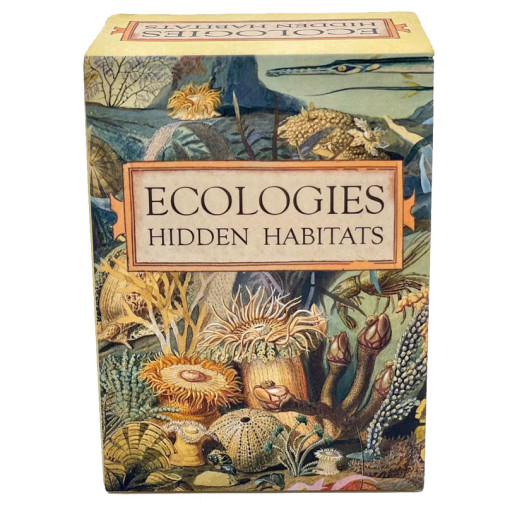We use cookies to make your experience better. To comply with the new e-Privacy directive, we need to ask for your consent to set the cookies. Learn more.
Ecologies Hidden Habitats Card Game
This edition focuses on 7 habitats we don’t often think of: islands, coral reefs, the Antarctic, and more.
This expansion pack can be played as a stand-alone or combined with the two previous games. The pack features awesome details regarding a wide variety of different animals and organisms, along with their food chain versatility. Includes 76 unique organisms and 7 biomes. 108 cards total. Playing time: 60-90 minutes, with 3 different game modes. For 1-6 players.
3rd Deck in the Series - Expansion or Stand Alone Game. This game is a sequel AND/OR an expansion. When using the game as an expansion, you can customize the deck to include cards from both games, including cards you love and excluding ones you don’t. Some players love aggressive “take that” mechanics, while others find them stressful. Some players love particular healthy ecology bonuses, while others feel they are overpowered. With multiple decks, you can create a customized experience to fit your group.
If you’d like to maintain the same game length and feel, we recommend choosing 10 factor cards and 7 different biomes. Note: more cards = a longer game
In ECOLOGIES, you build and maintain food webs in diverse biomes around the world. Each biome has a different ecology, and gives unique rewards when it is healthy and balanced. But watch out, your opponents may decide it's easier to disturb and degrade your ecosystems than nurture their own. In this hectic environment, you must choose how best to protect and care for your ecologies.
Designed by a biology teacher, the game includes 76 unique organisms, 7 biomes, and beautiful vintage Victorian art. (108 cards total). The gameplay is rooted in authentic science, as it is used in the classroom to teach real concepts to biology students. While it is scientific enough for the classroom, it is also strategic enough for any game night.
It's a dog-eat-dog world in Ecologies – well, actually, it's a dog-eat-rat world, ecologically speaking! The goal of this delightfully educational game is to create sustainable ecosystems across environments such as Desert, Grassland, and Ocean. Beautifully illustrated cards serve as these Biomes, as well as the Plants and Animals within them. Players take turns drawing and playing cards to create balanced ecologies. For instance, a healthy temperate forest ecology contains blackberries (producing plant), bees (to feed on the blackberries), frogs (to eat the bees), hawks (to eat the frogs), and earthworms (to decompose everything). Once a biome is complete, it offers bonuses ranging from points, to extra cards, to sabotaging another player's ecosystem. The trick is that players can only play cards "up" the food chain, and players are limited to a small handful of cards, often leaving half-finished ecosystems worth very few points. To alleviate this danger, players are encouraged to make trades – sometimes asymmetrical – with their competitors. It's not uncommon for players to offer up a fistful of unusable animals in exchange for the one missing link they need to complete their ecosystem! Adding another element of unpredictability are powerful Biotic and Abiotic Factor cards, providing bonuses to oneself or inflicting setbacks upon opponents. With gorgeous John James Audubon-style artwork, open gameplay, and vocabulary and animal diet information galore, this game is equally at home as a science supplement or a family game. For 1-6 players, with a playing time of 30-60 minutes. Each edition contains all-new biomes, animals, and Biotic and Abiotic factor cards, and can be played standalone or mixed with the original game.
| Product Format: | Other |
|---|---|
| Brand: | Montrose Biology |
| Grades: | 4-AD |
| EAN/UPC: | 860003217726 |
| Length in Inches: | 3.625 |
| Width in Inches: | 2.5 |
| Height in Inches: | 1.75 |
| Weight in Pounds: | 0.5 |

